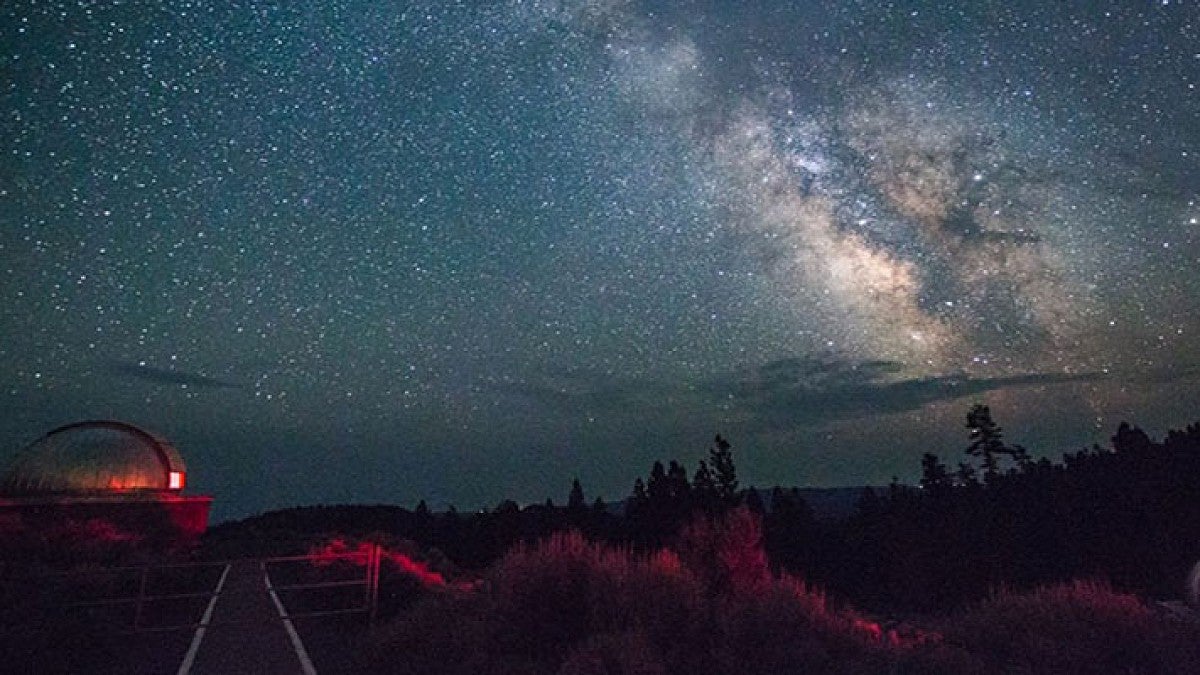Just because you’re heading out on a summer road trip doesn’t mean you have to leave the University of Oregon behind.
Head east of the Cascades and into Oregon’s high desert on a moonless night and make your way up to Pine Mountain Observatory, elevation 6,300 feet, run by the UO on Deschutes National Forest land.
There, on Friday and Saturday nights through Labor Day, you’ll be greeted by friendly UO students and faculty members who will guide you to telescopes pointing to the heavens.
“Pine Mountain is within one of the darkest remaining patches of sky in the continental United States,” said UO physicist Scott Fisher, director of the observatory. “With that comes the vista of the heavens. This summer, the stars of the show are Jupiter and Saturn, which will be up all summer.”
The view on a moonless night also includes a horizon-to-horizon view of the entire Milky Way, he said.
The site was discovered by UO professors Russ Donnelly and E.G. Ebbinghausen in 1965 and has been in operation as an observatory since 1967. It features four telescopes, including two open for public observation.
Here’s what to know, if you go:
The observatory is open to the public Friday and Saturday nights from Memorial Day weekend through Labor Day. Tours may be available during the week by advance appointment.
Getting there: The observatory is 34 miles southeast of Bend in Central Oregon — about an hour’s drive. From Bend, take Highway 20 east toward Burns. After 26 miles, just beyond the tiny Millican store (which is closed), turn right (or south) on the dirt road and follow it to the top of Pine Mountain, about eight miles.
Being there: The observatory is at 6,300 feet, so it gets cold at night, so be sure to bring warm clothes, food and water and have enough fuel in your tank to make the trip back to Bend.
When to go: Weather permitting, you can visit any weekend. But check for the best dates; “Dark Moon” weekends are best, while full moon weekends are less favorable.
Plan to arrive after sunset but before 10 p.m. Depending on conditions or turnout, telescopes may be shut down or put away by 11 p.m. or earlier, though on clear moonless nights the 24-inch telescope is normally open until midnight.
Visitors are asked to make a $5 donation per person at donation boxes in the welcome center and telescope domes.
Bring a small flashlight to find your way in the dark, but you will be required to cover the white lens with a red-colored shield to protect visitors’ night vision. Red cellophane and rubber bands will be available to cover your flashlight at the welcome center.
Camping is permitted at a primitive Forest Service campground just across the road from the observatory, available on a first-come, first served basis. Though rarely full, it may be prudent to call ahead to see how busy the observatory schedule is, especially during new moon dates. The campground features four drive-in sites that can accommodate trailers up to 27 feet in length, and 10 hike-in sites for tent camping. There are no camping fees. The campground has one outhouse and no power hookups, water or trash service.
Dogs are not allowed on the grounds of the observatory when it is open to the public.
For more information, or to schedule group visits, contact operations manager Alton Luken at 541-382-8331 or aluken@uoregon.edu.
Other UO points of interest
The University of Oregon has other facilities outside Eugene as well as on campus that make for fun summer visits.
In Charleston on the Oregon Coast, near Coos Bay, you can visit the Charleston Marine Life Center, part of the UO’s Oregon Institute of Marine Biology. The center features aquariums highlighting different coastal ecosystems, a tidepool touch tank, whale and sea lion skeletons, video from deep reefs and undersea volcanoes and various specimens reflecting the diversity of sea life off Oregon’s coast.
Visiting Portland? Stop by the Portland campus, housed in the historic White Stag Block and the adjacent 109 NW Naito building. You can pick up a souvenir or a snack at the Duck Store and explore the Willamette waterfront.
Having a staycation? Check out Jordan Schnitzer Museum of Art and the Museum of Natural and Cultural History on the main campus in Eugene. Both museums have cool exhibitions (literally and figuratively) going on this summer.
—By Tim Christie, University Communications


